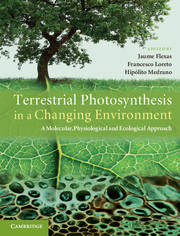 Terrestrial Photosynthesis in a Changing Environment
Terrestrial Photosynthesis in a Changing Environment Book contents
- Frontmatter
- Contents
- List of contributors
- Preface
- Acknowledgements
- List of abbreviations
- 1 Terrestrial photosynthesis in a changing environment
- Part I Photosynthesis
- Part II Measuring photosynthesis
- Part III Photosynthetic response to single environmental factors
- Part IV Photosynthesis in time
- 23 Photosynthesis during leaf development and ageing
- 24 Evolution of photosynthesis I: basic leaf morphological traits and diffusion and photosynthetic structures
- 25 Evolution of photosynthesis II: evolution and expansion of CAM and C4 photosynthetic types
- Part V Photosynthesis in space
- Part VI Photosynthesis in a global context
- References
- Index
24 - Evolution of photosynthesis I: basic leaf morphological traits and diffusion and photosynthetic structures
Published online by Cambridge University Press: 05 March 2013
- Frontmatter
- Contents
- List of contributors
- Preface
- Acknowledgements
- List of abbreviations
- 1 Terrestrial photosynthesis in a changing environment
- Part I Photosynthesis
- Part II Measuring photosynthesis
- Part III Photosynthetic response to single environmental factors
- Part IV Photosynthesis in time
- 23 Photosynthesis during leaf development and ageing
- 24 Evolution of photosynthesis I: basic leaf morphological traits and diffusion and photosynthetic structures
- 25 Evolution of photosynthesis II: evolution and expansion of CAM and C4 photosynthetic types
- Part V Photosynthesis in space
- Part VI Photosynthesis in a global context
- References
- Index
Summary
Introduction
The photochemical and biochemical processes that utilise solar energy for the synthesis of complex organic molecules have been on Earth for more than 3.5 billion years (Blankenship, 1992). The original photosynthetic mechanisms are thought to have been similar to those of contemporary cyanobacteria, with an oxygen-evolving photosystem that was responsible for the oxygenation of our early atmosphere, although physical processes have also been suggested (Kump, 2008). Evidence of the ancient origins of photosynthesis is seen in the fossil records of stromatolites of Western Australia (Awramik, 1992). Molecular studies show that it is increasingly more likely that photosynthesis evolved after chemolithotrophy (Xiong and Bauer, 2002). The evolutionary path of type-I and type-II reaction-centre systems remains unresolved and there is some debate on whether the earliest O2-producing cyanobacteria used water or bicarbonate as the terminal reductant that led to an aerobic atmosphere (Dismukes et al., 2001). There is evidence that the reaction giving rise to molecular oxygen, and responsible for our contemporary aerobic atmosphere, arose only once and the structural characteristics of its catalytic centre and its mechanism have been conserved ever since (Barber, 2008a,b). The origin of this oxygenic photosynthesis is under debate, with some authors suggesting an origin as early as 3.8 GA (Buick, 2008).
The Calvin-Benson or C3 cycle of carbon reduction evolved early in the history of life and this is reflected in its universal presence in photosynthetic plants. Evolution of the carbon-reducing steps of the Calvin cycle is thought to have occurred when the Earth’s atmosphere was hypoxic and rich in CO2, which may account for the extreme sensitivity of Rubisco, the enzyme responsible for CO2 entry into the Calvin cycle, to contemporary oxygen levels (Ogren, 1984). Presumably, a long period of evolution in a hypoxic atmosphere resulted in a complex pathway of tightly coupled reactions that have not been amenable to evolutionary modification in a way that reduces O2 inhibition of photosynthesis while retaining the original carbon-fixation function. Under current atmospheric conditions, the O2 inhibition of photosynthesis occurs through oxygenation of RuBP and subsequent loss of CO2 through the reactions of photorespiration.
- Type
- Chapter
- Information
- Terrestrial Photosynthesis in a Changing EnvironmentA Molecular, Physiological, and Ecological Approach, pp. 373 - 385Publisher: Cambridge University PressPrint publication year: 2012
- 5
- Cited by
